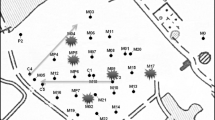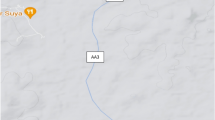Abstract
By comparing three sequential extraction procedures, a new optimized extraction scheme for the molybdenum association in environmental samples was proposed. Five operational steps were described as exchangeable (KH2PO4 + K2HPO4: including water-soluble), associated with organic matter (NaOH), Fe–Mn oxides and/or carbonates (HCl), sulfides (H2O2) and residue (HNO3 + HF + H2O2). An optimized extraction scheme was compared with Tessier’s procedure and the Commission of European Communities Bureau of Reference (BCR) was applied to black shales. Results showed Tessier’s procedure gave the lowest concentration values for exchangeable molybdenum and the highest values for the residual molybdenum, which could not present the efficiency of the extraction reagents. BCR’s procedure showed the highest values in oxidizable molybdenum and presented four fractions of molybdenum, which did not demonstrate the fractions of molybdenum in the black shales in detail. The optimized extraction scheme demonstrated a certain improvement on extraction efficiency over Tessier’s procedure for the lowest residual molybdenum, and revealed more featured fraction information of molybdenum in black shales than BCR’s. Therefore, after a comparison with other two extraction procedures, the optimized extraction scheme proved suitable for the molybdenum in black shales and it also showed an accurate determination of the molybdenum in the fractions and source of bioavailable Mo.
Similar content being viewed by others
References
Anbar AD, Rouxel O (2007) Metal stable isotopes in paleoceanography. Annu Rev Earth Planet Sci 35:717–746
Arnon DI (1958) The role of micronutrients in plant nutrition with special reference to photosynthesis and nitrogen assimilation. Trace Elements 1:123–128
Aydin I, Aydin F, Hamamci C (2012) Molybdenum speciation in asphaltite bottom ash (Seguruk, SE Anatolia, Turkey). Fuel 95:481–485
Berner RA, Baldwin T, Holdren GR Jr (1979) Authigenic iron sulfides as paleosalinity indicators. J Sediment Res 49:1345–1350
Bortels H (1930) Effects of molybdenum on nitrogen metabolism of sugarcane. Arch Mikrobior 1:333–342
Bostick BC, Fendorf S, Helz GR (2003) Differential adsorption of molybdate and tetrathiomolybdate on pyrite (FeS2). Environ Sci Technol 37:285–291
Bullen DT, Eisenhauser A (2006) Metal stable isotopes: signals in the environment. Elements 5:349–385
Cary EE, Wieczorek GA, Allaway WH (1967) Reactions of selenite-selenium added to soils that produce low-selenium forages. Soil Sci Soc Am J 31:21–26
Davidson CM, Thomas RP, McVey SE (1994) Evaluation of a sequential extraction procedure for the speciation of heavy metals in sediments. Anal Chim Acta 291:277–286
Davidson CM, Ferreira PCS, Ure AM (1999) Some sources of variability in application of the three-stage sequential extraction procedure recommended by BCR to industrially-contaminated soil. Fresenius’ J Anal Chem 363:446–451
Erickson BE, Helz GR (2000) Molybdenum (VI) speciation in sulfidic waters: stability and lability of thiomolybdates. Geochim Cosmochim Acta 64:1149–1158
Filgueiras AV, Lavilla I, Bendicho C (2002) Chemical sequential extraction for metal partitioning in environmental solid samples. J Environ Monit 4:823–857
Fox PM, Doner HE (2003) Accumulation, release, and solubility of arsenic, molybdenum, and vanadium in wetland sediments. J Environ Qual 32:2428–2435
Johnson CM, Beard BL, Albarède F (2004) Overview and general concepts. Rev Miner Geochem 55:1–24
Ken KC, Lo SL (2002) Desorption kinetics of PCP-contaminated soil: effect of temperature. Water Res 36:284–290
Koschinsky A, Halbach P (1995) Sequential leaching of marine ferromanganese precipitates: genetic implications. Geochim Cosmochim Acta 59:5113–5132
Kuhn T, Bostick BC, Koschinsky A, Halbach P, Fendorf S (2003) Enrichment of Mo in hydrothermal Mn precipitates: possible Mo sources, formation process and phase associations. Chem Geol 199:29–43
Kulp TR, Pratt LM (2004) Speciation and weathering of selenium in Upper Cretaceous chalk and shale from South Dakota and Wyoming, USA. Geochim et Cosmochim Acta 68:3687–3701
Luque-Garcıa JL, De Castro ML (2003) Ultrasound: a powerful tool for leaching. TrAC Trends Anal Chem 22:41–47
Morford JL, Emerson S (1999) The geochemistry of redox sensitive trace metals in sediments. Geochim Cosmochim Acta 63:1735–1750
Neunhäuserer C, Berreck M, Insam H (2001) Remediation of soils contaminated with molybdenum using soil amendments and phytoremediation. Water Air Soil Pollut 128:85–96
Orberger, B., Vymazalova, A., Wagner, C., Fialin, M., Gallien, J. P., Wirth, R.,… & Montagnac, G., 2007. Biogenic origin of intergrown Mo-sulphide-and carbonaceous matter in Lower Cambrian black shales (Zunyi Formation, southern China). Chemical Geology. 238, 213–231
Pérez-Cid B, Boia C (2001) Comparison between total determination and extractable heavy metals from river sediments using conventional and microwave accelerated leaching tests. Int J Environ Anal Chem 81:101–115
Pumure I, Renton JJ, Smart RB (2010) Ultrasonic extraction of arsenic and selenium from rocks associated with mountaintop removal/valley fills coal mining: estimation of bioaccessible concentrations. Chemosphere 78:1295–1300
Quevauviller P, Ure A, Muntau H, Griepink B (1993) Improvement of analytical measurements within the BCR-programme: single and sequential extraction procedures applied to soil and sediment analysis. Int J Environ Anal Chem 51:129–134
Rauret G, Rubio R, Lopez-Sanchez JF (1989) Optimization of Tessier procedure for metal solid speciation in river sediments. Int J Environ Anal Chem 36:69–83
Shi J, Liao Z (2001) Bioinorganic chemistry. 165–169
Tessier A, Campbell GPC, Bisson M (1979) Sequential extraction procedure for the speciation of particulate trace metals. Anal Chem 51:844–851
Tribovillard N, Riboulleau A, Lyons T, Baudin F (2004) Enhanced trapping of molybdenum by sulfurized marine organic matter of marine origin in Mesozoic limestones and shales. Chem Geol 213:385–401
Vorlicek TP, Kahn MD, Kasuya Y, Helz GR (2004) Capture of molybdenum in pyrite-forming sediments: role of ligand-induced reduction by polysulfides. Geochim Cosmochim Acta 68:547–556
Wang HF, Li JQ (1996) Geological characteristic of Shuanghe selenium deposit in Enshi, Hubei Province. Hubei Geol 2:10–21
Wang D, Aller RC, Sañudo-Wilhelmy SA (2011) Redox speciation and early diagenetic behavior of dissolved molybdenum in sulfidic muds. Mar Chem 125:101–107
Wilde P, Lyons TW, Quinby-Hunt MS (2004) Organic carbon proxies in black shales: molybdenum. Chem Geol 206:167–176
International Humic Substances Society (IHSS) http://www.humicsubstances.org/
Žemberyová M, Hagarova I, Zimova J, Kuss HM (2010) Determination of molybdenum in extracts of soil and sewage sludge CRMs after fractionation by means of BCR modified sequential extraction procedure. Talanta 82:582–586
Zhu JM, Qin HB, Lee L, Zuo W, Lei L, Su H (2007) The method for analyzing state of selenium in Se-rich environmental samples. Bull Mineral Petrol Geochem 26:209–213
Zhu JM, Johnson TM, Clark SK, Zhu XK, Wang XL (2014) Selenium redox cycling during weathering of Se-rich shales: a selenium isotope study. Geochim Cosmochim Acta 126:228–249
Acknowledgments
This work was financially supported by the National Key Basic Research Program of China (2014CB238903), the Natural Science Foundation of China (41073017, 41273029) and the Opening Fund of State Key Laboratory of Environmental Geochemistry. The authors appreciate the help and advice from Assistant Professor Hai-bo Qin of the Chinese Academy of Sciences Institute of Geochemistry.
Author information
Authors and Affiliations
Corresponding author
Rights and permissions
About this article
Cite this article
Liang, L., Zhu, JM. An optimized sequential extraction scheme for molybdenum association in environmental samples. Acta Geochim 35, 111–119 (2016). https://doi.org/10.1007/s11631-016-0096-4
Received:
Revised:
Accepted:
Published:
Issue Date:
DOI: https://doi.org/10.1007/s11631-016-0096-4




